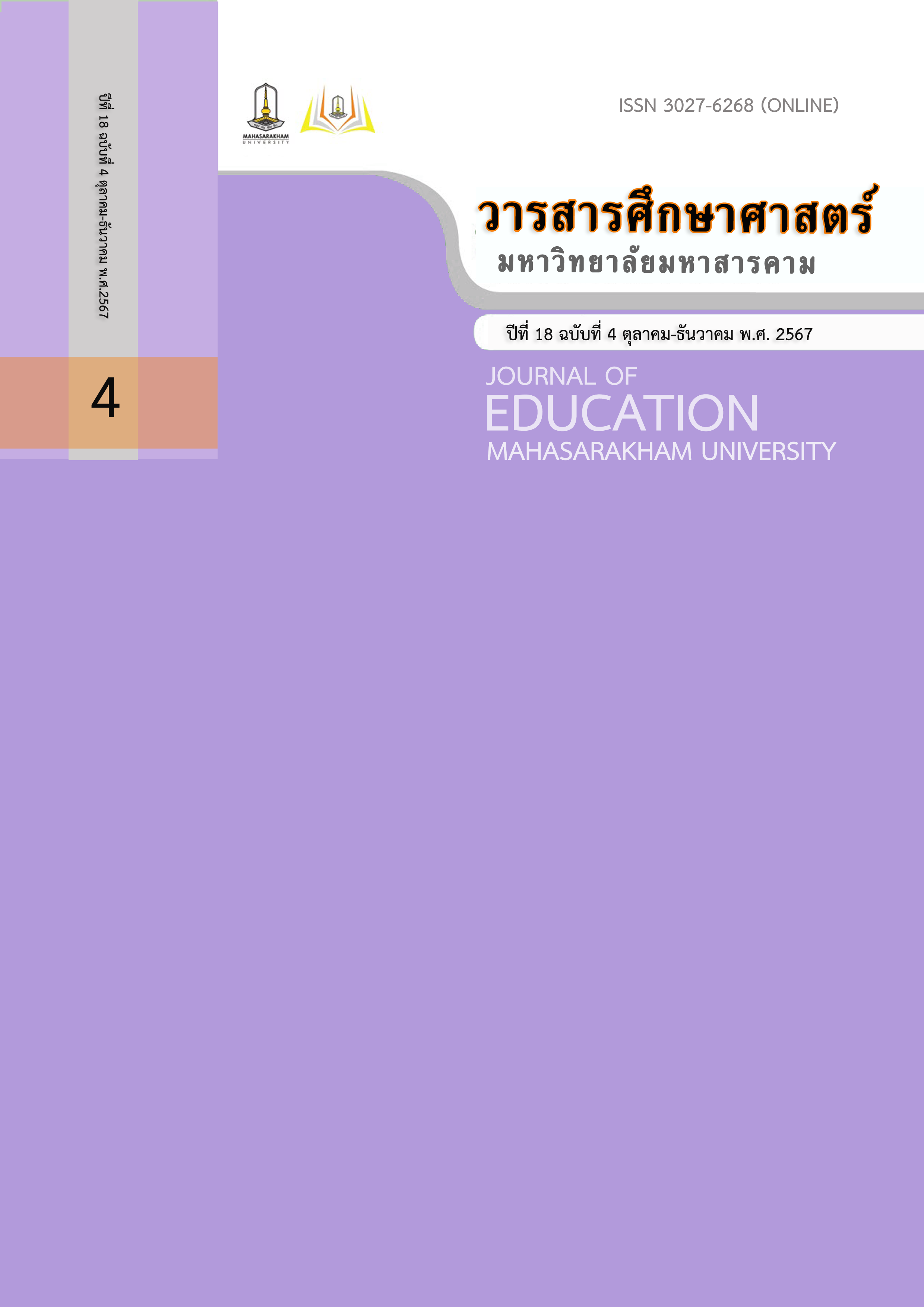การพัฒนากิจกรรมการเรียนรู้โดยใช้กิจกรรมเป็นฐานร่วมกับเทคนิค Math Talk Moves ที่มีต่อทักษะการสื่อสารทางคณิตศาสตร์ เรื่องความน่าจะเป็น ของนักเรียนชั้นมัธยมศึกษาปีที่ 3
Main Article Content
บทคัดย่อ
การวิจัยครั้งนี้มีวัตถุประสงค์เพื่อ 1) ศึกษาแนวทางการจัดกิจกรรมการเรียนรู้โดยใช้กิจกรรมเป็นฐานร่วมกับเทคนิค Math Talk Moves โดยใช้รูปแบบการวิจัยเชิงปฏิบัติการในชั้นเรียนที่มีผู้ร่วมสะท้อนผล 3 คน ผลการสะท้อนผลจากแต่ละวงจรปฏิบัติการ นำไปปรับปรุงและพัฒนาการจัดกิจกรรมการเรียนรู้ในวงจรปฏิบัติการถัดไป 2) ศึกษาทักษะการสื่อสารทางคณิตศาสตร์ของนักเรียนชั้นมัธยมศึกษาปีที่ 3 กลุ่มตัวอย่างในการวิจัยคือนักเรียนชั้นมัธยมศึกษาปีที่ 3 ภาคเรียนที่ 2 ปีการศึกษา 2566 โรงเรียนประจำอำเภอแห่งหนึ่งในจังหวัดพิจิตร จำนวน 30 คน เครื่องมือที่ใช้ในการวิจัยได้แก่ 1) แผนการจัดการเรียนรู้ เรื่อง ความน่าจะเป็น 3 แผน 2) แบบวัดทักษะการสื่อสารทางคณิตศาสตร์ แบบอัตนัย 3 ชุด 3) แบบสังเกตพฤติกรรมการสื่อสารทางคณิตศาสตร์ของนักเรียน และ 4) แบบสะท้อนผลการจัดกิจกรรมการเรียนรู้โดยใช้กิจกรรมเป็นฐานร่วมกับเทคนิค Math Talk Moves วิเคราะห์ข้อมูลโดยใช้การวิเคราะห์เชิงเนื้อหา ตรวจสอบความน่าเชื่อถือแบบสามเส้าโดยใช้แหล่งข้อมูลมากกว่าหนึ่งแหล่ง สถิติที่ใช้คือ ค่าเฉลี่ย ส่วนเบี่ยงเบนมาตรฐานและ การทดสอบค่า t ผลการวิจัยพบว่า 1) แนวทางการจัดกิจกรรมเรียนรู้โดยใช้กิจกรรมเป็นฐาน (ABL) ร่วมกับเทคนิค Math Talk Moves เพื่อส่งเสริมทักษะการสื่อสารทางคณิตศาสตร์ มีประเด็นที่ควรเน้นและแนวปฏิบัติที่ดี ได้แก่ (1) การทบทวนความรู้เดิมและการตรวจสอบความพร้อมของนักเรียน (2) การใช้สถานการณ์ปัญหาที่เชื่อมโยงกับสถานการณ์ปัญหาเดิม (3) การทำงานร่วมกันเป็นกลุ่ม (4) การนำเสนอและการพูดคุยถึงผลลัพธ์ของกลุ่มตนเอง (5) การประเมินผลด้วยใบงานหรือแบบฝึกทักษะ 2) ผลการศึกษาทักษะการสื่อสารทางคณิตศาสตร์ของนักเรียนมัธยมศึกษาปีที่ 3 พบว่านักเรียนมีคะแนนทักษะการสื่อสารด้วยการพูดและการเขียนสูงขึ้นเมื่อเปรียบเทียบแต่ละวงจรปฏิบัติการ อย่างมีนัยสำคัญทางสถิติที่ระดับ .05
Downloads
Article Details

อนุญาตภายใต้เงื่อนไข Creative Commons Attribution-NonCommercial-NoDerivatives 4.0 International License.
เอกสารอ้างอิง
จิตติมา ชอบเอียด. (2551). การใช้ปัญหาปลายเปิดเพื่อส่งเสริมทักษะการให้เหตุผลและทักษะการสื่อสารทางคณิตศาสตร์ของนักเรียนชั้นมัธยมศึกษาปีที่ 1. กรุงเทพฯ: มหาวิทยาลัยศรี-นครินทรวิโรฒ.
พิมพ์สุภา วุ่นเหลี่ยม. (2563). ความสามารถในการแก้ปัญหาและการสื่อสารทางคณิตศาสตร์ เรื่อง สมการเชิงเส้นตัวแปรเดียวของนักเรียนชั้นมัธยมศึกษาปีที่ 1 โดยใช้วิธีการแบบเปิด. มหาสารคาม: มหาวิทยาลัยมหาสารคาม.
มัณฑนา เลิศเสรีพัฒนกุล, และทรงชัย อักษรคิด. (2562). การศึกษาผลการจัดการเรียนรู้โดยใช้กิจกรรมเป็นฐานร่วมกับการฝึกให้นักเรียนยกตัวอย่างสนับสนุนและตัวอย่างค้าน เรื่อง “ความน่าจะเป็น” ของนักเรียนชั้นมัธยมศึกษาปีที่ 3. วารสารวิชาการมหาวิทยาลัยอีสเทิร์นเอเชีย ฉบับสังคมศาสตร์และมนุษยศาสตร์, 9(2), 115–125.
ยุทธพงษ์ สีม่วง. (2562). การพัฒนากิจกรรมการเรียนรู้ท้องถิ่นตามแนวทางสะเต็มศึกษา เพื่อส่งเสริมทักษะการเรียนรู้ในศตวรรษที่ 21 สำหรับนักเรียนชั้นมัธยมศึกษาตอนต้น. วารสารวิชาการ มหาวิทยาลัยกรุงเทพธนบุรี., 8(1), 47–58.
รัตนะ บัวสนธ์. (2564). การวิจัยและการพัฒนานวัตกรรมการศึกษา. พิมพ์ครั้งที่ 5. กรุงเทพฯ: สำนักพิมพ์จุฬาลงกรณ์มหาวิทยาลัย.
รุ่งอรุณ ลียะวณิชย์ (2555). คู่มือครูคณิตศาสตร์ การสอนคณิตศาสตร์ด้วยเกม. พิมพ์ครั้งที่ 1. กรุงเทพฯ: บริษัทแอคทิฟ พริ้นท์ จำกัด.
สถาบันส่งเสริมการสอนวิทยาศาสตร์และเทคโนโลยี. (2558). การศึกษาคณิตศาสตร์ในระดับโรงเรียนไทย: การพัฒนา – ผลกระทบ – ภาวะถดถอยในปัจจุบัน. กรุงเทพฯ: สถาบันส่งเสริมการสอนวิทยาศาสตร์และเทคโนโลยี (สสวท.).
_______. (2560). คู่มือการใช้หลักสูตร กลุ่มสาระการเรียนรู้คณิตศาสตร์ (ฉบับปรับปรุง พ.ศ.2560) ตามหลักสูตรแกนกลางการศึกษาขั้นพื้นฐาน พุทธศักราช 2551. กรุงเทพฯ: สถาบันส่งเสริมการสอนวิทยาศาสตร์และเทคโนโลยี.
________. (2560). ตัวชี้วัดและสาระการเรียนรู้แกนกลาง กลุ่มสาระการเรียนรู้คณิตศาสตร์ (ฉบับปรับปรุง พ.ศ. 2560) ตามหลักสูตรแกนกลางการศึกษาขั้นพื้นฐาน พุทธศักราช 2551. กรุงเทพฯ: โรงพิมพ์ชุมนุมสหกรณ์การเกษตรแห่งประเทศไทย จำกัด.
สํานักงานคณะกรรมการการศึกษาขั้นพื้นฐาน. (2562). แนวทางการนิเทศเพื่อพัฒนาและส่งเสริมการจัดการเรียนรู้เชิงรุก (Active Learning) ตามนโยบายลดเวลาเรียนเพิ่มเวลารู้. สืบค้น 20 เมษายน 2566, จาก http://academic.obec.go.th/images/document/ 1603180137_d_1.pdf
สิรินภา กิจเกื้อกูล. (2557). การจัดการเรียนรู้วิทยาศาสตร์: ทิศทางสำหรับครูศตวรรษที่21. เพชรบูรณ์: จุลดิสการพิมพ์.
สุพรรณี ชาญประเสริฐ. (2557). Active Learning: การจัดการเรียนรู้ในศตวรรษที่ 21. นิตยสาร สสวท., 42(188), 3–6.
Fuson, K. C., & Leinwand, S. (2023). Building Equitable Math Talk Classrooms. Mathematics Teacher: Learning and Teaching PK-12, 116(3), 164–173.
Kemmis, & McTaggart, R. (1988).The Action research planner, (3 rd ed). Geelong: Deakin University, Australia
Maulyda, M. A., Annizar A. M., & Mukhlis M. (2019). Analysis of students’ verbal and written mathematical communication error in solving word problem. Journal of Physics: Conference Series, 2020(1538).
National Council of Teachers of Mathematics (NCTM). (2000). Principles and Standards for School Mathematics. Reston, VA: The National Council of Teachers of Mathematics, Inc.
Pokhrel, T. R. (2018). Activity Based Mathematics Instruction: Experinces in Addressing the 21st-Century Skills. Journal of Mathematics Education, 11(1), 46-61.
Yarmasi, Y., Fonna, M., & Mursalin, M. (2020). The Influence of Cooperative Learning Model Type Team Assisted Individualized of Interactive Media Assistance to Students' Mathematical Communication Ability. International Journal for Educational and Vocational Studies, 2(9).


